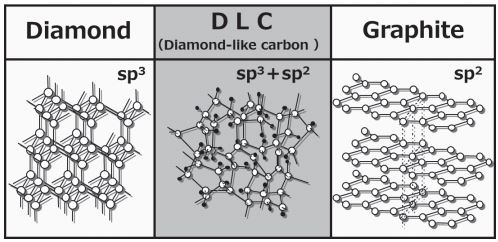I am currently working as a Postgraduate Researcher at the University of Leeds, where I am actively involved in research activities. Prior to this, I successfully completed my master's degree through the renowned Erasmus Mundus joint program, specializing in Tribology and Bachelor's degree in Mechanical Engineering from VTU in Belgaum, India. Further I handle the social media pages for Tribonet and I have my youtube channel Tribo Geek.
Tribology of Diamond like carbon (DLC) coatings
Table of Contents
Introduction
DLC (Diamond-Like Carbon) films are a type of thin coating that possesses properties resembling those of diamond. They are composed primarily of carbon atoms and exhibit a wide range of hardness and friction values, making them versatile for various applications. DLC films are known for their high wear resistance and low friction characteristics, which make them suitable for reducing friction and extending the lifespan of surfaces. In engineering materials, hardness and stiffness are often crucial factors that determine their ability to withstand loads and exhibit wear resistance [1]. Generally, materials with high hardness and stiffness tend to have higher wear resistance. Diamond, renowned for its exceptional hardness and extreme wear resistance, serves as a prime example of such a material. However, it’s important to note that there is no universal correlation between hardness and friction coefficients for various materials and coatings. While hardness is a significant factor in wear resistance, it doesn’t directly dictate friction coefficients. Other factors, such as surface texture, lubrication, and the specific materials involved, can influence friction coefficients independently of hardness. Therefore, assessing friction performance requires considering multiple variables beyond just hardness. Recently, diamond and DLC coatings have gained significant attention due to their exceptional properties, making them highly sought after for demanding applications [2].

Fig-1 DLC coating composition [3]
Synthesis of DLC films
At present, there are several PVD (Physical Vapor Deposition) and CVD (Chemical Vapor Deposition) methods available for depositing DLC films. The deposition temperature range for these methods varies widely, ranging from sub-zero temperatures to 400°C. Additionally, depending on the specific deposition method employed, parameters such as deposition pressure and bias voltage can also be adjusted over broad ranges to achieve desired film properties and characteristics. A notable characteristic of DLC films is their ability to be deposited on various types of substrate materials. However, the strength of bonding or adhesion between DLC films and substrates can significantly vary depending on the chemical nature of the substrates. In most tribological applications, it is crucial for DLC films to establish strong bonding with the substrates. Insufficient bonding can lead to premature fracturing and delamination of the DLC films from the surface, especially when subjected to high normal and/or shear forces during sliding contacts. Therefore, achieving robust bonding between DLC films and substrates is essential for their effective performance in tribological applications [4].

Fig-2 DLC coating synthesis by Mitsubishi Industries [5]
Friction and wear of DLC films
The friction and wear properties of DLC films can vary significantly depending on their specific type, as well as the test conditions and environmental factors involved. DLC films exhibit a wide range of friction values, spanning from 0.001 to 0.7, which is among the broadest observed in comparison to other materials or coatings. This variation in friction and wear can be attributed to a combination of intrinsic and extrinsic factors. Intrinsic factors, such as the chemical composition and structural characteristics of the DLC film, play a significant role in determining its friction and wear behavior. Extrinsic factors encompass the test conditions, including material parameters like substrate and counterface materials, contact pressure, motion type, speed, ambient temperature during sliding tests, and the nature of the test environment. These extrinsic factors have a considerable impact on the friction and wear performance of DLC films [6].

Fig-3 Optical images of the wear tracks of the DLC coated disks deriving from the test in humid air [7]
The surface roughness of DLC film’s sliding surfaces has a notable effect on friction and wear. The relative contribution of each interaction type to overall friction can vary considerably and is strongly influenced by specific test conditions such as load, speed, motion type, and distance. The chemical properties of the test environment, ambient temperature, and the counterface material composition also play significant roles. Additionally, the presence or absence of a transfer film on the counterface material’s sliding surfaces, as well as the physical and chemical characteristics of such films, can impact friction behavior. Consequently, both surface roughness and environmental factors surrounding the sliding interface have an influence on the overall friction experienced by DLC films.
Reference
[3] https://pcs-instruments.com/articles/the-science-behind-diamond-like-coatings-dlcs/
[5] https://www.mhi.com/group/mhims/research/sip/column_0001.html
[6] Bhushan, B., 2000. Modern tribology handbook, two volume set. CRC press.

Be the first to comment